Learn how to make traditional and authentic Maharashtrian Misal Pav at home using homemade Kolhapuri-style masala. This popular street food features a spicy and flavorful sprouts curry (known as misal) served with buttery pav (bread rolls) and topped with crunchy farsan, chopped onions, and a squeeze of lemon. It's a wholesome, and naturally vegan dish that's perfect for breakfast, brunch, or even dinner. If you're craving bold flavors and comforting textures, this Misal Pav recipe is just what you need-easy to make, customizable, and absolutely delicious!
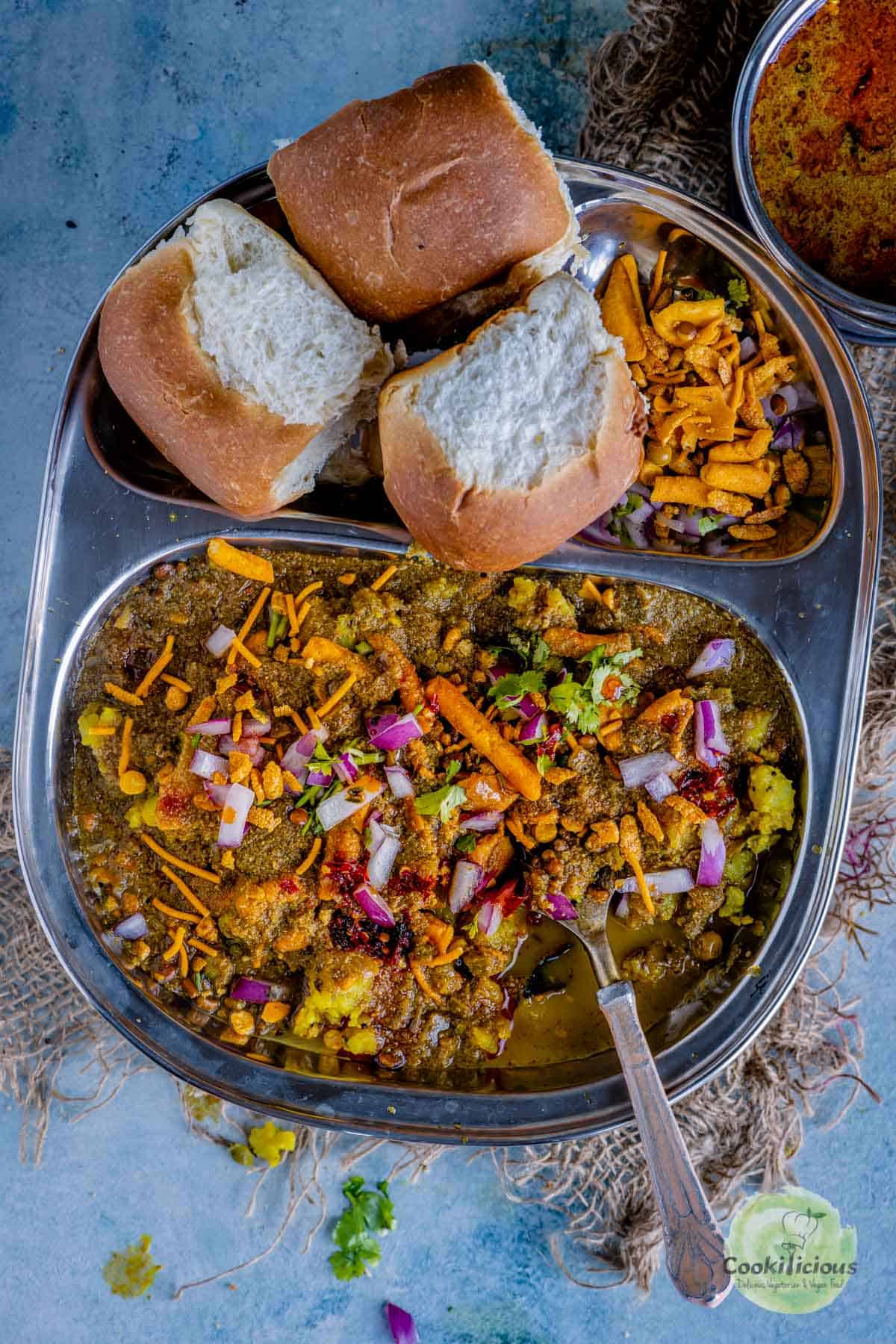
Jump to:
What is Misal Pav
Misal Pav is a popular and flavorful street food from Maharashtra, made up of two main components: Misal, a spicy dry curry made from sprouted moth beans and a special ground masala called Vatan, and Tarri (also known as Kat or Rassa), a fiery red, thin gravy that's poured over the misal before serving. It's typically enjoyed with buttered pav (bread rolls), and topped with farsan, chopped onions, and a squeeze of lemon.
This hearty and wholesome dish is packed with bold spices, protein, fiber, and carbs-making it not just delicious but also filling and nourishing. Misal Pav is usually served as a snack or breakfast and holds a special place in Maharashtrian cuisine.
Orgination of Misal Pav
It's believed that the Misal Pav recipe originated in Nashik nearly 100 years ago. It was first served in factory canteens as an affordable, energy-boosting meal for workers. Over time, the recipe evolved as people across Maharashtra-and later Mumbai-began adding their own regional flair to it.
Many street food vendors around Mumbai serve their own take on Misal Pav, and I've been lucky to try several of them. It's one of my all-time favorite snacks, and I love making this elaborate, authentic version for special occasions like KR's birthday or when we have guests over for a house party.
Types of Misal
Misal Pav varies regionally across Maharashtra, each with its own distinct flavor and spice level. The Kolhapuri Misal is known for its fiery spice and layered components without poha, while the Puneri Misal is milder and includes poha for a softer texture.
Nashik Misal features a balanced, less spicy flavor, and Varhadi Misal from the Varhad region is aromatic and spicy with unique local spices. Thane Misal offers a slightly sweet note alongside its spicy tarri. These regional variations highlight the rich diversity of this popular Maharashtrian street food.
This is the Kolhapuri Misal Version
To make traditional Kolhapuri Misal, you start with a base layer of potato curry spread on the serving plate. This is followed by a generous helping of spicy sprouted bean curry, known as usal. Next, the signature spicy thin gravy called tarri (also called kat or rassa) is poured over the top. The dish is then garnished with crunchy farsan (savory Indian snack mix), fresh cilantro, lemon juice, and finely chopped onions. Everything is mixed together before eating, which is why it's called misal-meaning "mixture" in Marathi.
If you're looking for a quicker option, I also have an Instant Pot recipe for Mumbai Matki Misal on the blog. However, this post walks you through the detailed, authentic process of making classic Maharashtrian Kolhapuri Misal Pav from scratch, perfect for those craving the real street food experience at home.
Why make this
- 🌱 Naturally vegan - Made without any dairy or animal products
- 🌾 Gluten-free friendly - Just swap the pav with gluten-free bread
- 🔥 Authentic Kolhapuri version - Bold, spicy, and full of flavor
- 🫘 Protein-rich sprouts curry - A nourishing vegan dish made with sprouted beans
- ⏱️ Make-ahead friendly - All components can be prepped in advance
- 👨👩👧👦 Perfect for gatherings - Easily scalable for large groups or parties
- 🇮🇳 Street-style Maharashtrian favorite - Brings the taste of Indian streets to your kitchen
- 🍛 Wholesome one-plate meal - Balanced with carbs, protein, fiber, and healthy fats
- ✨ Unique, layered flavors - A feast for the senses in every bite
Ingredients needed 🧾
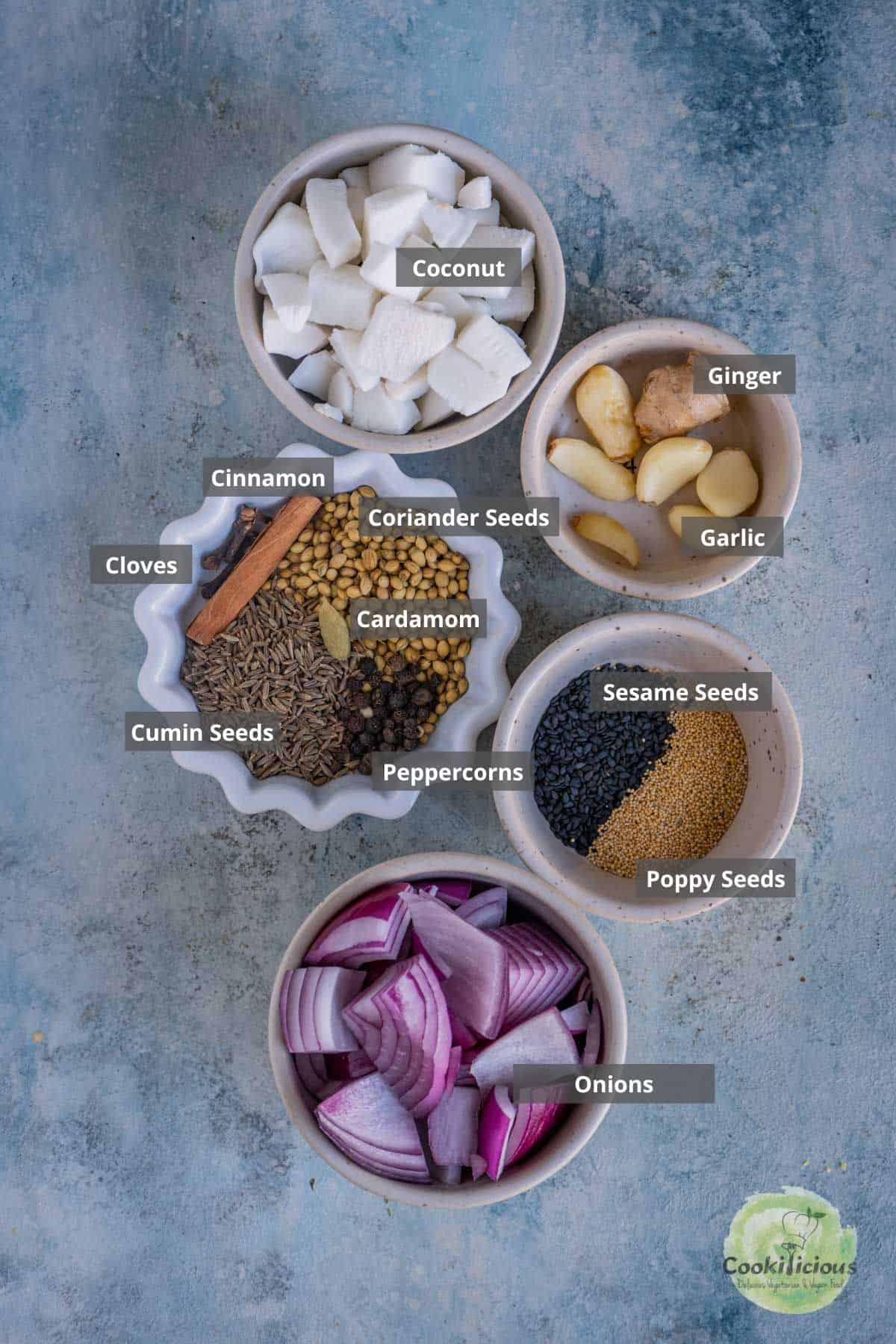
To make Misal Vatan Masala
The heart of an authentic Kolhapuri Misal Pav lies in its flavorful Vatan Masala-a ground spice blend that adds depth, aroma, and that signature fiery punch.
🌿 Whole Spices - This homemade masala includes coriander seeds, cumin seeds, black peppercorns, white or black sesame seeds, poppy seeds, cloves, green cardamom, and cinnamon. These spices lend the Vatan its earthy, rustic, and robust flavor-true to traditional Maharashtrian cooking.
🥥 Coconut - I've used fresh coconut chunks in this recipe for a rich, creamy texture. You can also substitute with dry, unsweetened shredded coconut or desiccated coconut if fresh isn't available.
🧄🧅 Aromatics - Onion, ginger, and garlic are essential to bring that extra zing, body, and aroma to the masala. They form the flavorful base of the curry.
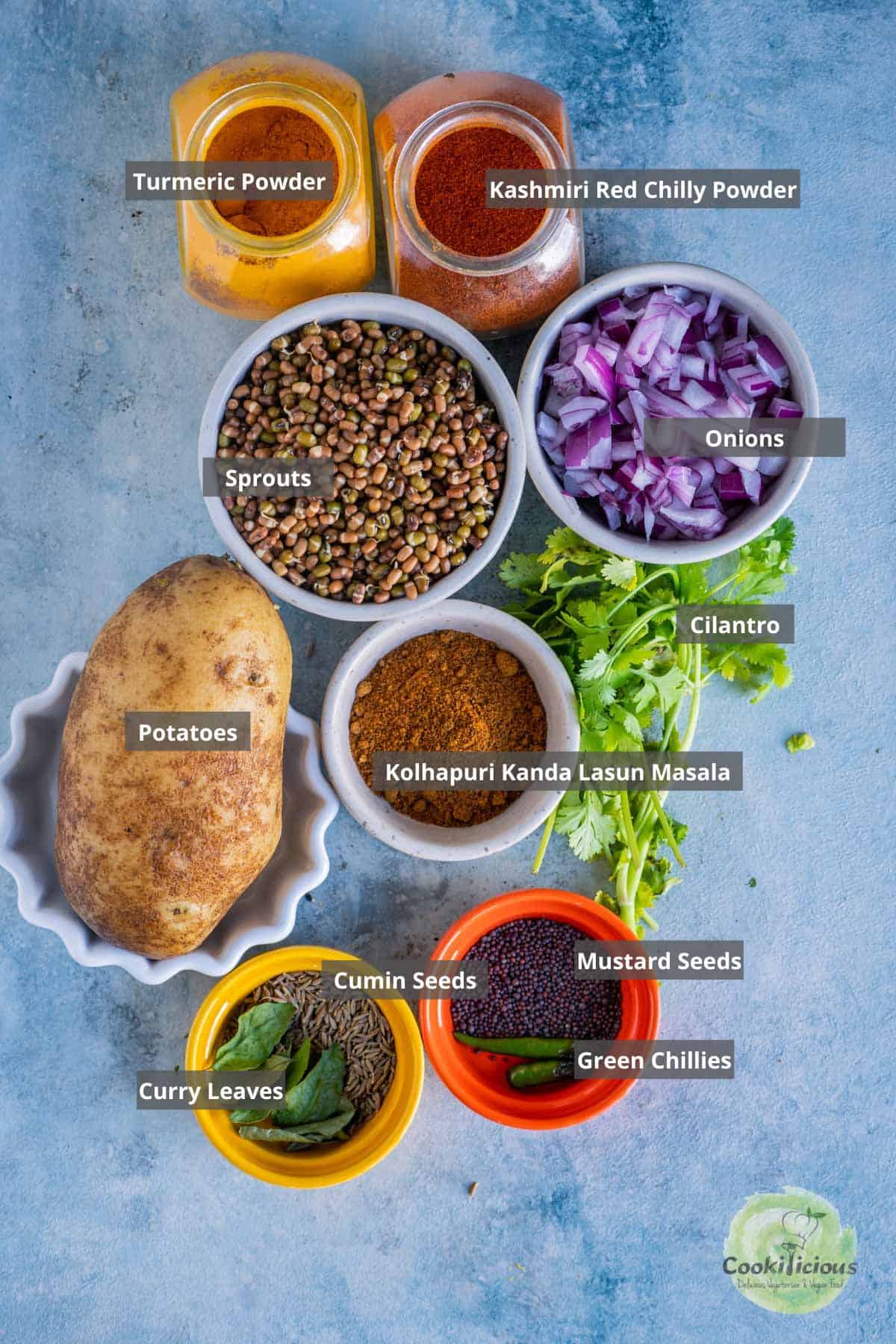
Other ingredients
To build the layers of flavor in this Kolhapuri Misal Pav, you'll need a few key ingredients beyond the Vatan masala:
- 🫘 Sprouts - I've used a mix of dry moth beans (matki) and mung beans (green gram) that I sprouted at home. Sprouting enhances their nutritional value, making them rich in protein and fiber. For convenience, you can also use frozen or store-bought sprouted beans.
- 🥔🧅 Vegetables - The two basic veggies you'll need are potatoes and onions. Potatoes form the base layer in the dish, while onions add sweetness and texture to the curry.
- 🌿 Spices, Herbs and Aromatics - Mustard seeds, cumin seeds, fresh curry leaves, green chilies, Kashmiri red chili powder (for color and mild heat), turmeric powder, and chopped cilantro bring aroma, color, and depth to the dish.
- 🔥 Kolhapuri Kanda Lasun Masala - This signature onion-garlic spice blend is commonly used in Kolhapuri cuisine. It adds a smoky, spicy kick and authentic flavor. You can make it at home or find it at Indian grocery stores or on Amazon. (Kanda means onion, and Lasun means garlic in Hindi.)
These ingredients come together to create the bold, layered, and hearty flavor that Misal Pav is famous for.
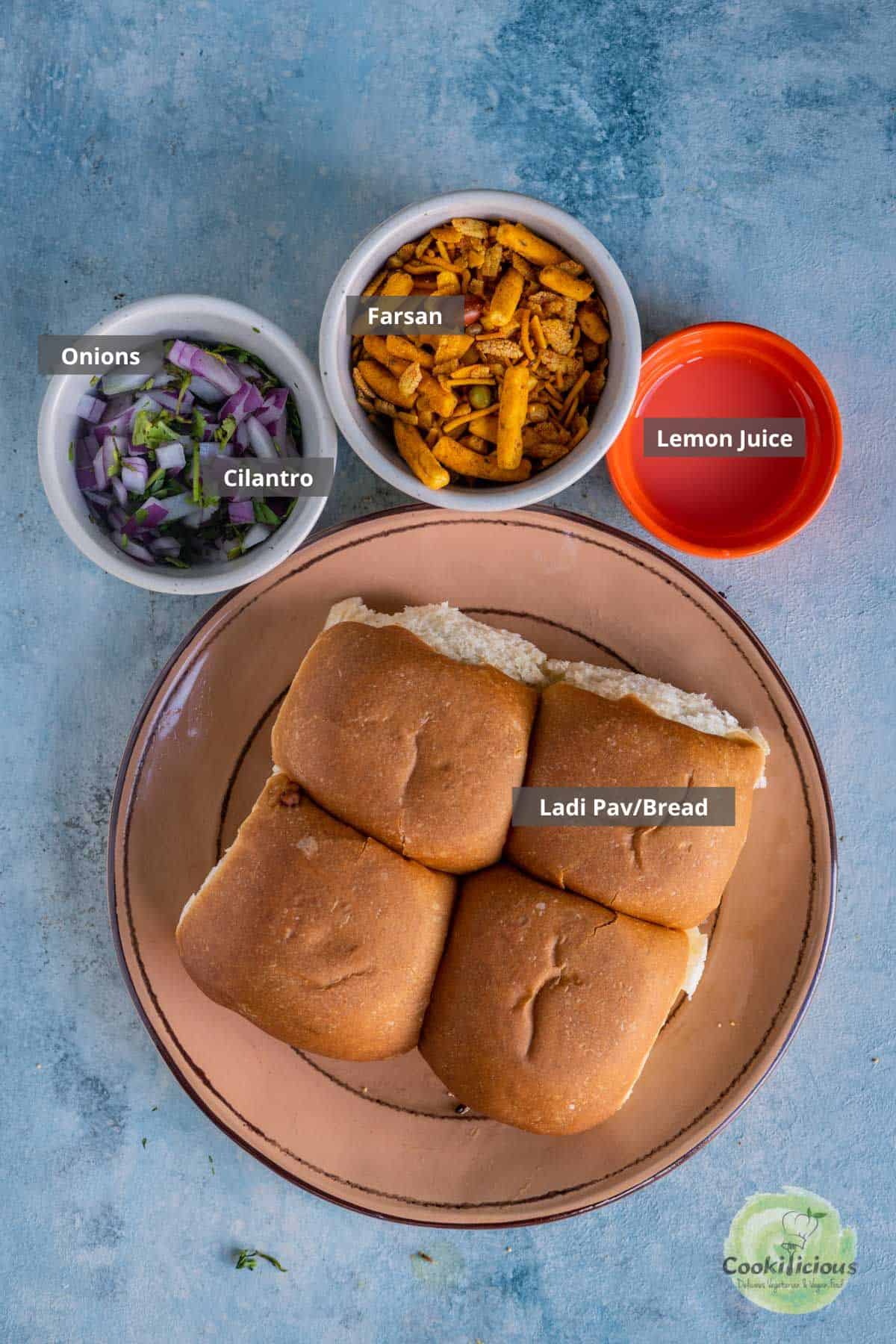
Finishing ingredients
The final garnishes and accompaniments are what complete the Kolhapuri Misal Pav experience, adding contrast in texture, freshness, and flavor.
- 🍞 Bread (Pav) - Misal is traditionally served with Ladi Pav, similar to what's used in popular Indian street foods like Vada Pav and Pav Bhaji. You can also use dinner rolls, burger buns, sourdough, sliced bread, or any gluten-free or healthier bread option. Just make sure the bread is soft and not sweet, as sweetness can overpower the spicy misal.
- 🔥 Farsan - This dry, spicy, and crunchy savory snack mix adds essential texture and flavor. Look for Misal Farsan at Indian grocery stores-it's specifically made for this dish. If unavailable, use sev, mixture, or bhujia as substitutes. The farsan soaks up the spicy tarri and adds that irresistible crunch.
- 🧅🌿🍋 Onions, Cilantro and Lemon Juice - These final toppings are non-negotiable. Chopped raw onions bring sharpness, fresh cilantro adds brightness, and a squeeze of lemon juice lifts the whole dish with a pop of acidity.
Together, these finishing touches elevate Misal Pav into a well-rounded, vibrant, and satisfying Maharashtrian street-style meal.
How to make it 🔪
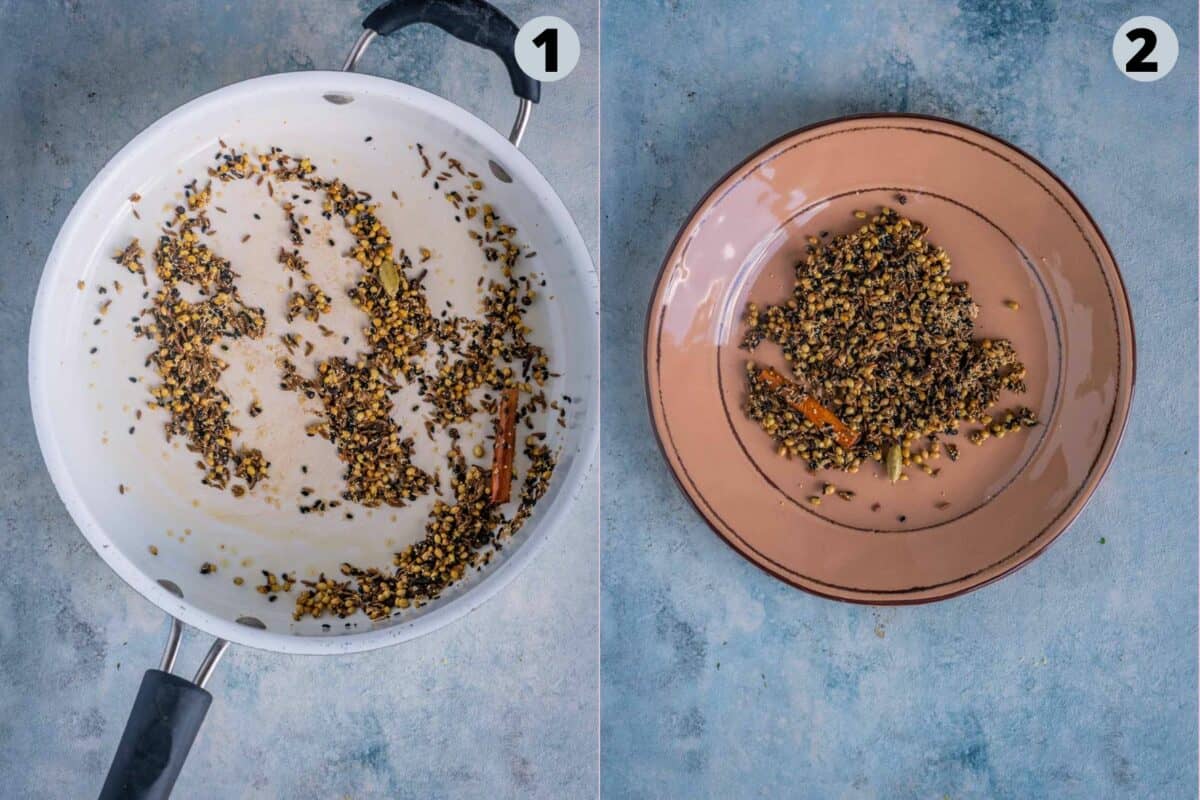
To make Misal vatan masala
- Roast coriander seeds, cumin seeds, peppercorns, cloves, cardamom pod, poppy seeds, sesame seeds, and cinnamon in oil for 2 minutes on low to medium flame. Chef Tip - They should be lightly roasted and not change color.
- Transfer to a plate and allow it to cool.
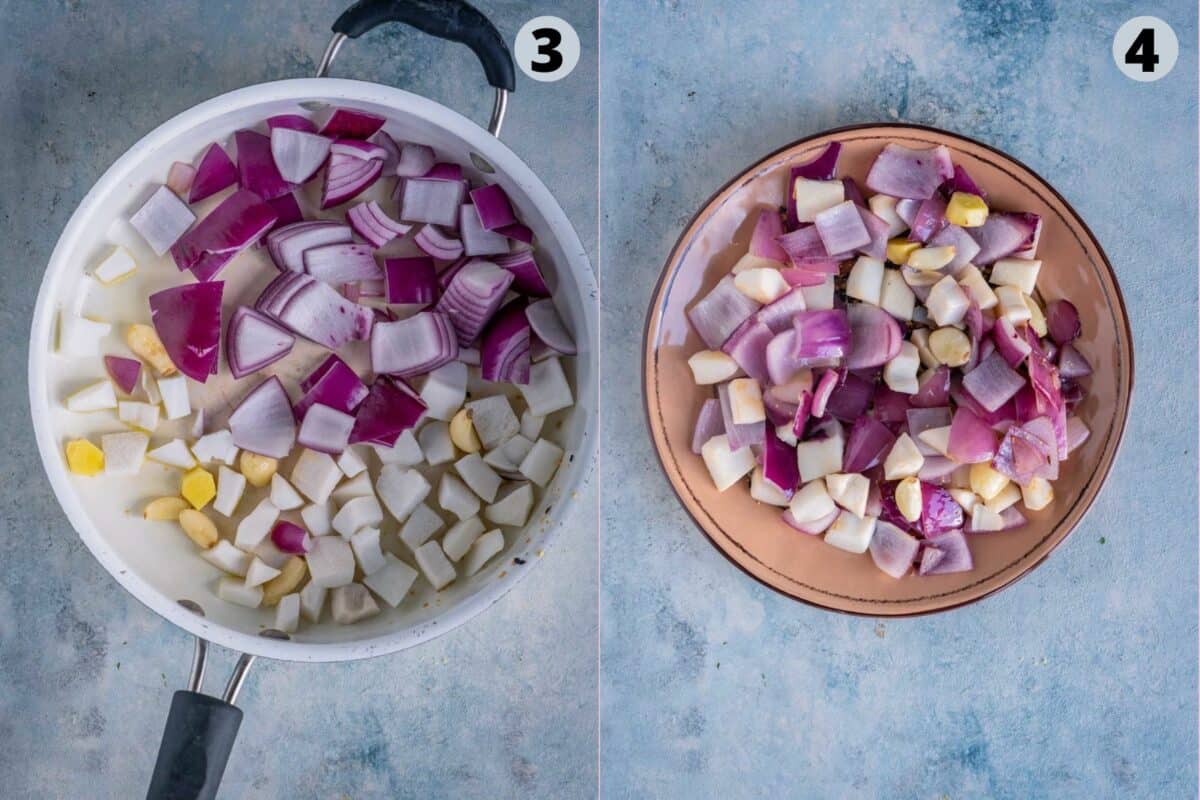
- In the same pan, roast garlic, ginger, onion, and coconut shreds. Add a teaspoon of more oil if needed. Roast for 4 minutes. Chef Tip - You can also use a grill pan here.
- Transfer to the same plate. Allow it to cool down completely.
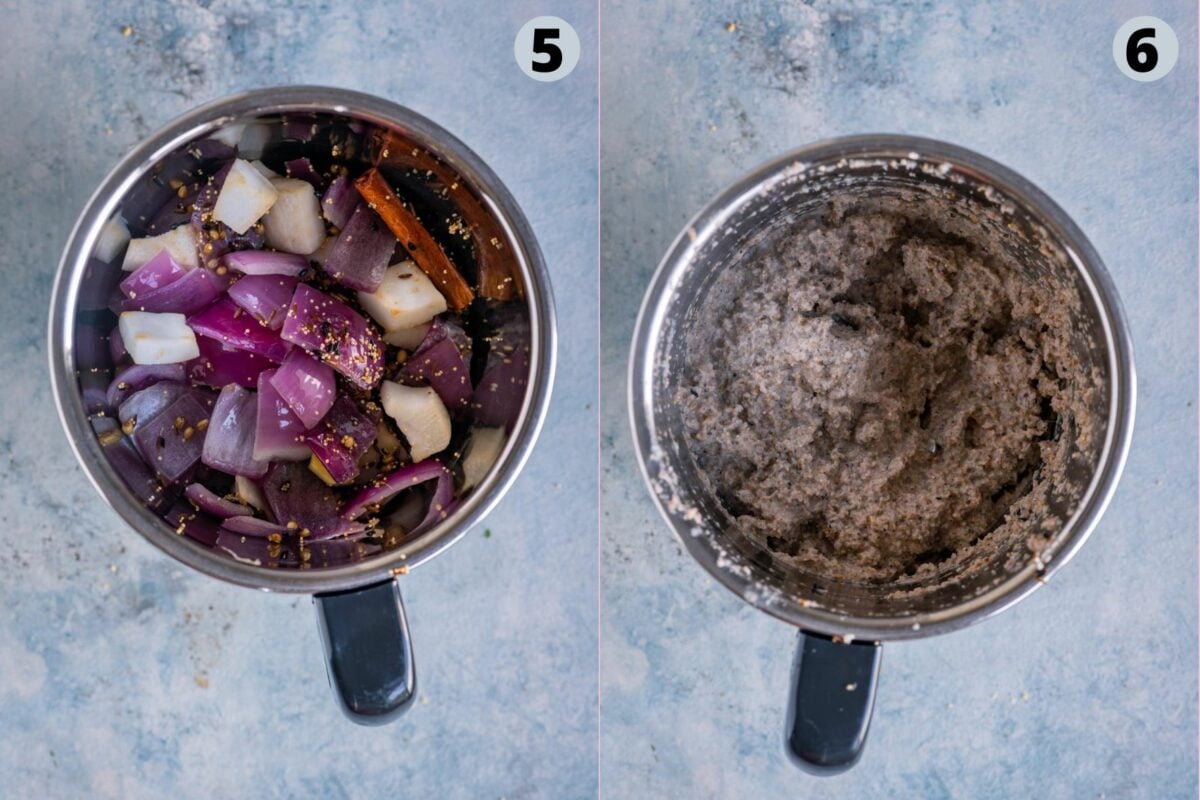
- Then transfer all the contents to a blender jar.
- Grind it to a smooth paste by adding water gradually. Keep this misal Vatan aside for now.

To cook the sprouts
- Add water, turmeric powder, and sprouts to a pan. Mix, cover, and cook it for 15 minutes or till the sprouts are almost done, on medium flame.
- Strain and reserve the water. That will be used to make the Tarri. Keep the cooked sprouts aside for now and then use it to make the curry.
Want to save this recipe?
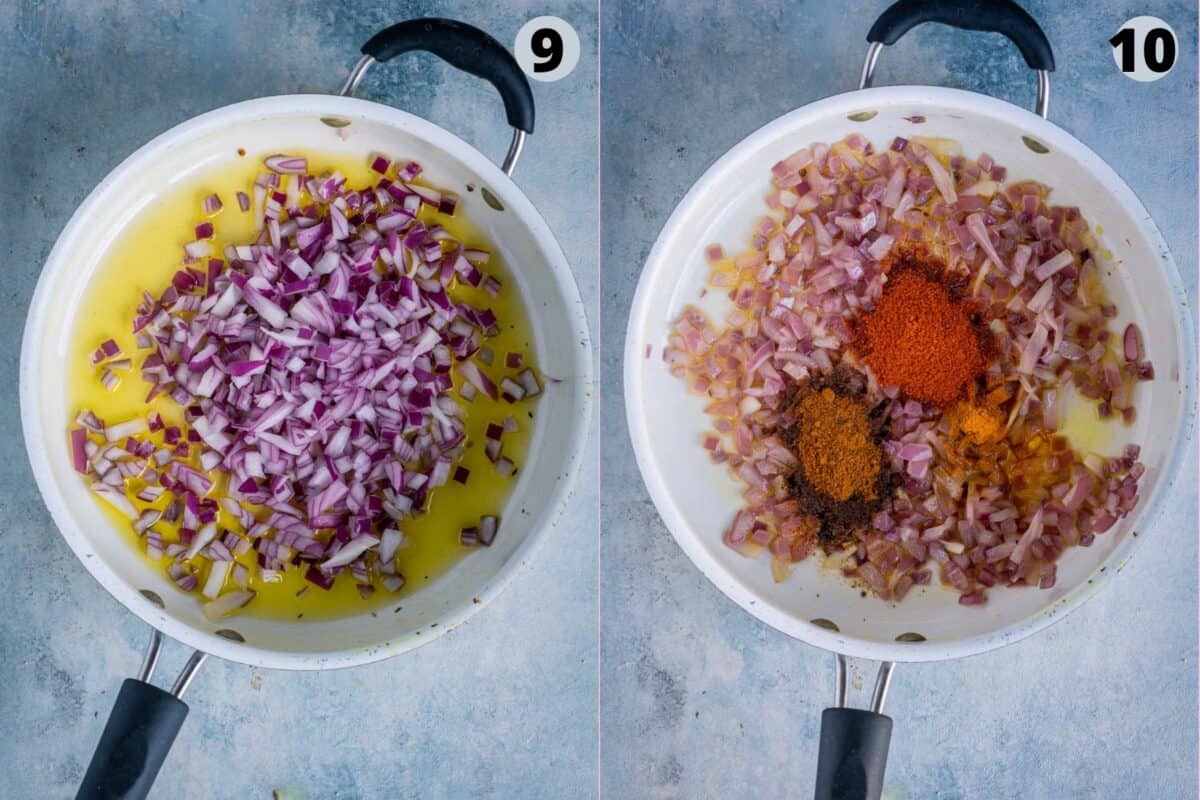
To make the Tarri
- Heat oil in the pan and fry the onions till they turn light golden brown. This could take 4-5 minutes on medium flame.
- Lower the flame and then add the Kolhapuri Kanda Lasoon masala, Kashmiri red chilly powder, and turmeric powder. Mix and sauté for 2 minutes.

- Now add the ground paste along with salt. Mix and cook till the masalas are all well cooked. It could take 12-15 minutes on medium flame. Chef Tip - Add little hot water if the mixture gets too dry. Keep stirring the masala and don't forget to scrape the sides of the pan as it cooks.
- Then add the sprouts water. I got 3.5 cups of stock. Mix and adjust the consistency as needed. I added an additional cup of water. It should be thin pouring consistency. Ensure there are no lumps.
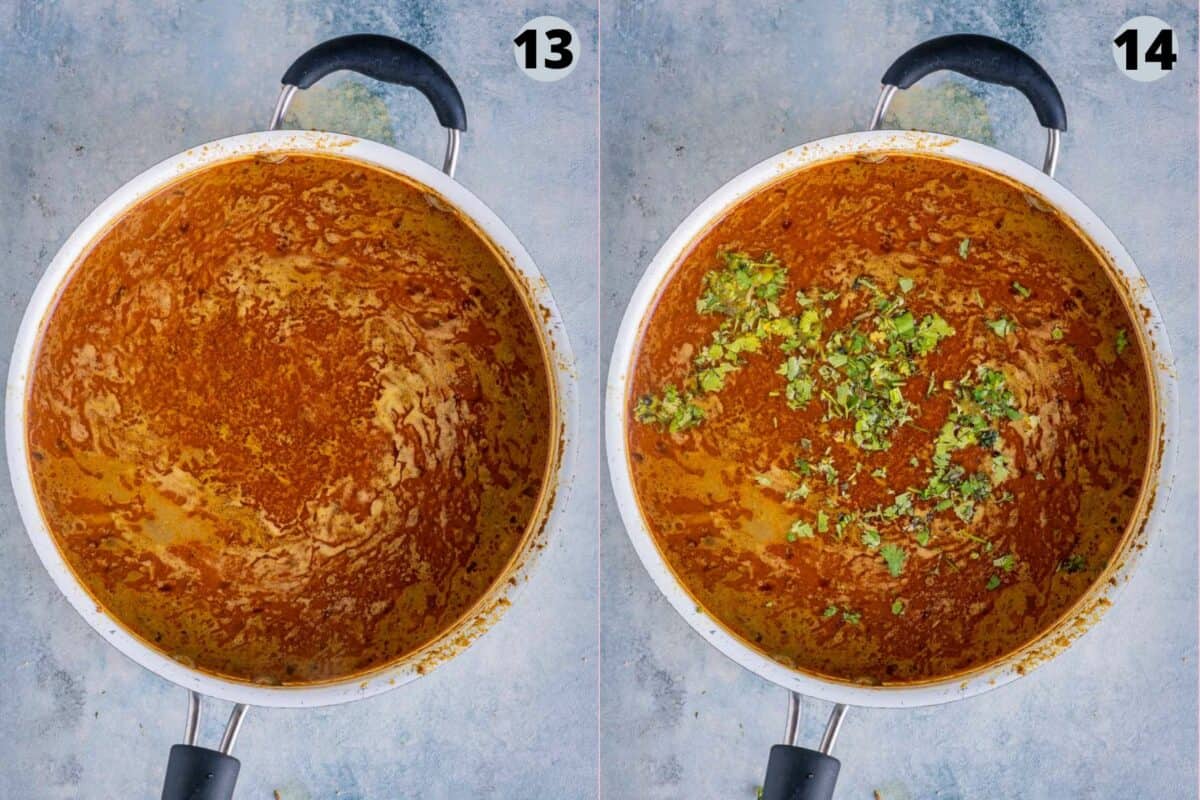
- Cook this Tarri for 20 minutes or till the oil floats on top, on medium flame. There is no need to cover the pan. Check and add salt if needed.
- Then add chopped cilantro and give it a good mix. Tarri is now ready. You can transfer this misal masala to a large bowl and keep it aside.
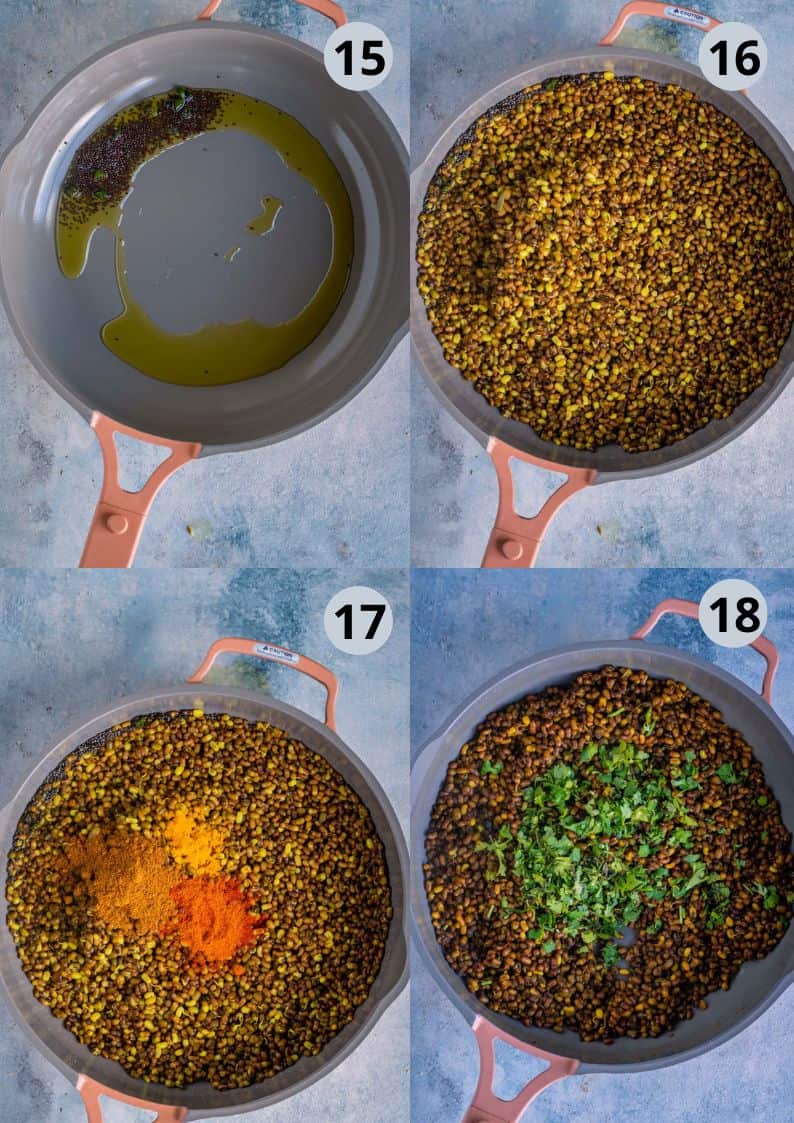
To make Matki chi Bhaji
- Heat oil in a pan and temper mustard seeds. Once they splutter, add the minced green chillies.
- Then add the cooked spouts.
- Followed by turmeric powder, Kashmiri red chilly powder, Kolhapuri Kanda Lasoon masala, and salt.
- Mix and cook this for 5-6 minutes. Keep stirring at intervals. Garnish with chopped cilantro. Matki chi bhaji is ready. Transfer to a bowl and keep it aside.
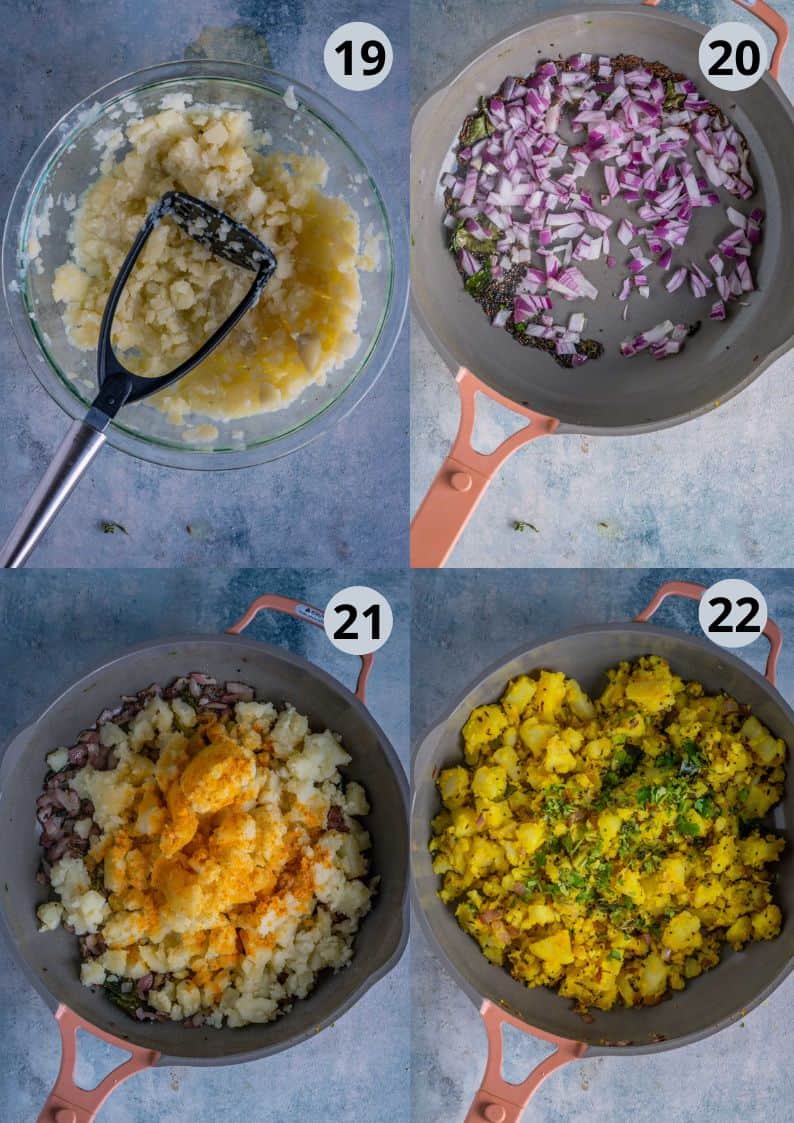
To make the potato bhaji
- Boil, peel, and mash or grate 3 potatoes.
- Heat oil in the same pan. Temper mustard seeds, cumin seeds, curry leaves, and green chillies. Then add onions and saute till they turn translucent.
- Now add the mashed potatoes along with salt and turmeric powder.
- Mix and cook for 4-5 minutes. Keep mashing some potatoes while cooking. Garnish with chopped cilantro. Mix and take it off the flame. Transfer to another bowl.
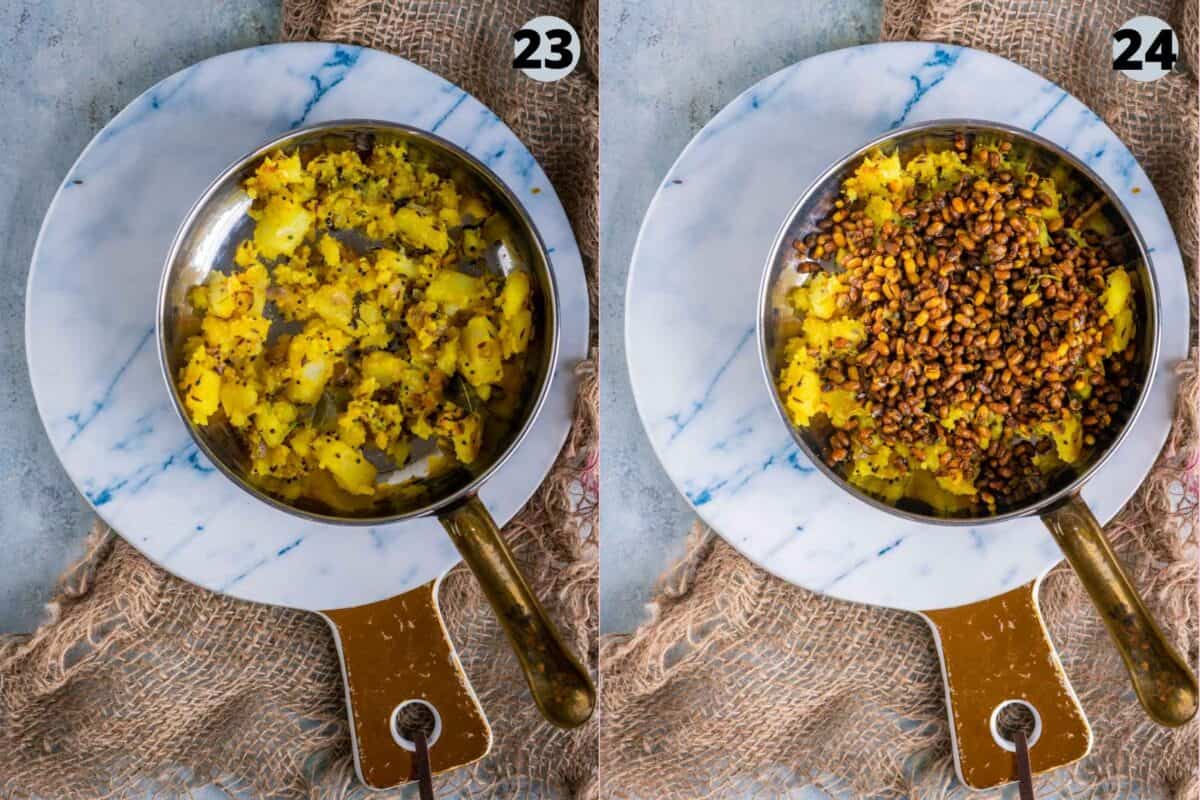
To assemble the misal pav
- On a small serving plate, add a portion of potato bhaji.
- Then add the matki chi bhaji on top.
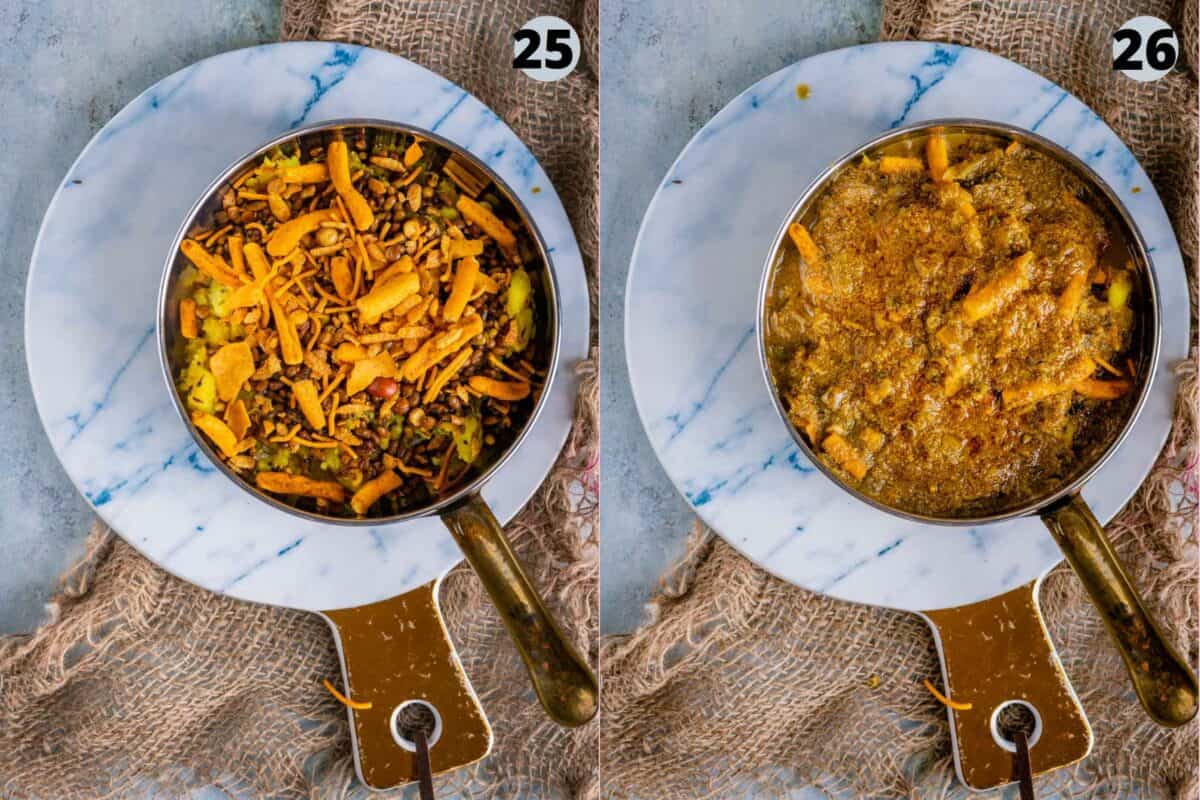
- Top with a generous helping of farsan.
- Pour the tarri on top.

- Garnish with chopped onions and cilantro.
- Add some lemon juice on top and serve with pav. If you want, you can also toast the pav with butter to give it more flavor.
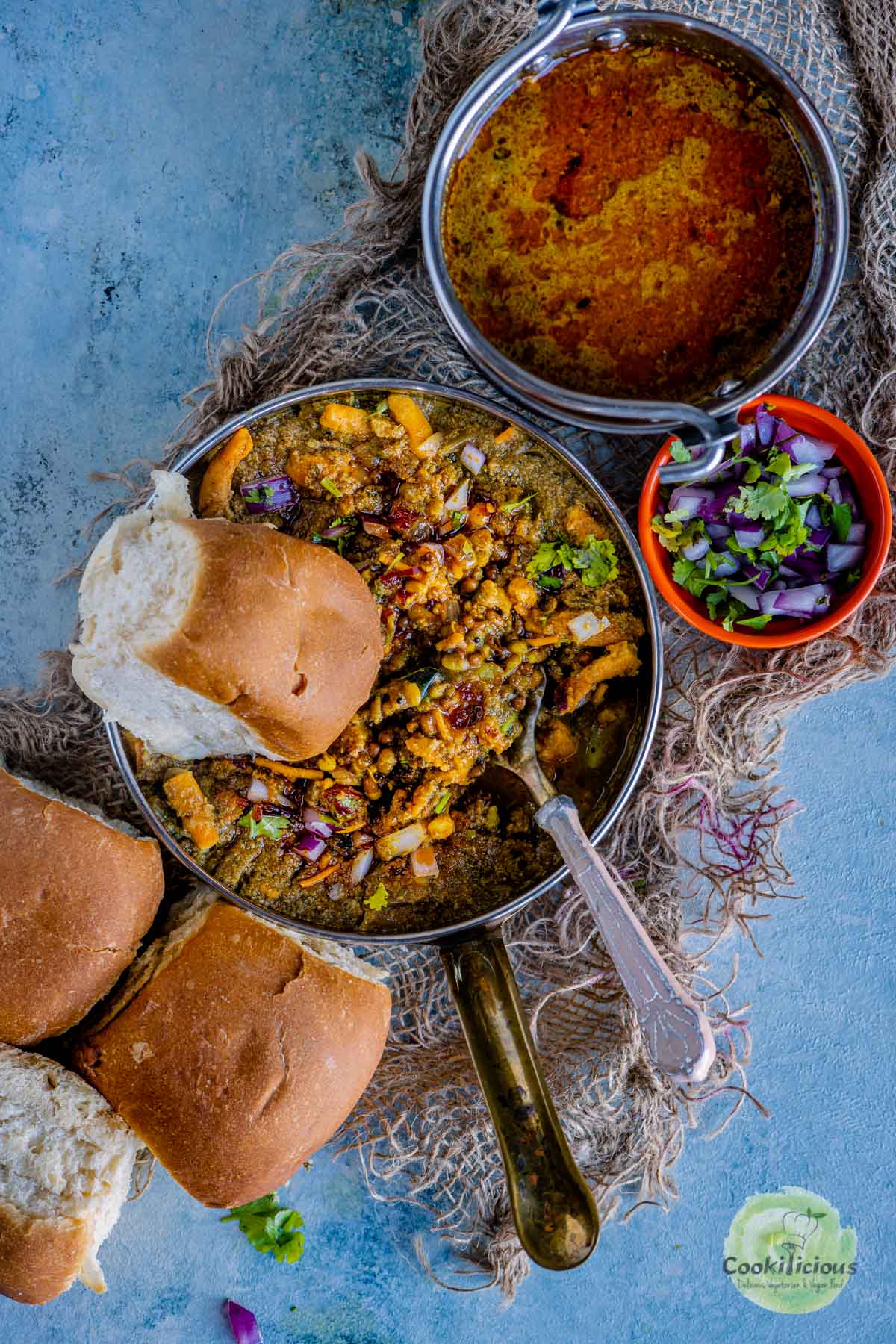
Serving suggestions 🍽
Traditionally, Misal Pav is served with soft Ladi Pav, water rolls, or pita bread-basically any non-sweet bread that can soak up the flavorful tarri. If you're gluten-free, feel free to use gluten-free bread or even a hearty whole grain roll.
If the Misal feels too spicy 🌶, add a spoonful of yogurt on top to balance the heat. You can also enjoy it with buttermilk, a glass of chaas, or even my fun twist-Chaas Popsicles-to cool things down!
This spicy sprouts curry also tastes incredible with steamed rice. For healthier options, try pairing it with cauliflower rice, brown rice, or quinoa.
Misal Pav is a versatile dish that can be served:
- 🥐 For breakfast or brunch
- 🫖 As a snack with tea or coffee
- 🍽️ As a wholesome lunch or dinner
- 🎉 At potlucks, parties, festive occasions, or weekend gatherings
Whether you're celebrating or simply craving something comforting and bold, this authentic Maharashtrian Misal Pav hits the spot every time.
Top recipe tips 💭
One way to cut down on cooking time when making Kolhapuri Misal Pav is to combine the sprouts curry (usal) and the tarri (spicy rassa) into one dish instead of preparing them separately. You can also skip the separate potato bhaji and simply add boiled, cubed potatoes directly into the curry. This not only reduces cooking steps but also saves on clean-up. To speed things up, consider using multiple pans and cook different elements simultaneously. These small adjustments can help you enjoy an authentic Misal Pav without spending hours in the kitchen.
Recipe FAQs 📖
All the components of Misal Pav can be made ahead of time and stored separately in the refrigerator for 4-5 days. You can even freeze the individual components-like the sprouts curry, tarri, and potato bhaji-for up to 2 months. Just thaw them overnight in the fridge and reheat in the microwave or on the stovetop before serving. However, for the best flavor and texture, it's highly recommended to assemble Misal Pav fresh.
The farsan should always be added just before serving, as it loses its crunch if left to sit in the curry. To make entertaining easy, keep all the elements in separate bowls and let guests build their own misal at the table. This ensures everyone enjoys the perfect balance of crunch, spice, and freshness.
Sprouting beans at home is simple and boosts their nutritional value, making them perfect for a wholesome Misal Pav.
Start by rinsing dry moth beans (brown matki) and/or green moong beans thoroughly under running water. Soak them in a bowl of water overnight on your countertop. The next morning, drain the water using a colander.
For natural sprouting, leave the soaked beans in the colander for 1-2 days, covered loosely with a lid or plate. Keep them on the counter at room temperature. Rinse them once daily to prevent drying out. You'll start seeing white sprouts emerge in a day or two.
Alternatively, you can wrap the drained beans in a moist muslin cloth, tie it up, and hang it or place it in a warm spot until they sprout.
For a quicker method, use an Instant Pot. Place the beans in the steamer basket inside the Instant Pot. Close the lid (no sealing needed) and set it to Yogurt mode for 24-36 hours, depending on how long you'd like the sprouts to grow.
👉 1 cup of dry beans yields about 2 to 2.5 cups of sprouted beans.
In this authentic Kolhapuri Misal Pav recipe, I've used a combination of matki (brown sprouts) and moong (green sprouts). However, you can easily adapt the recipe based on what you have on hand. Feel free to use just one type of sprout, or even add soaked but unsprouted vatana-whether yellow, white, or green dried peas-for a similar hearty texture.
If you don't have Kolhapuri Kanda Lasun Masala, you can either make it at home or substitute it with goda masala, pav bhaji masala, or garam masala. While these alternatives will slightly alter the signature Kolhapuri flavor, the dish will still be delicious. I've used a homemade masala, but store-bought versions from Indian grocery stores or online retailers also work well.
In a pinch, you can even use a basic curry powder from your local supermarket. Although it won't replicate the bold, fiery taste of traditional misal, it's a convenient option when you're short on time or ingredients.
If you're making the Puneri Misal variation, you can replace the potato bhaji layer with Kanda Poha-a quick and flavorful alternative made with flattened rice.
More street food recipes
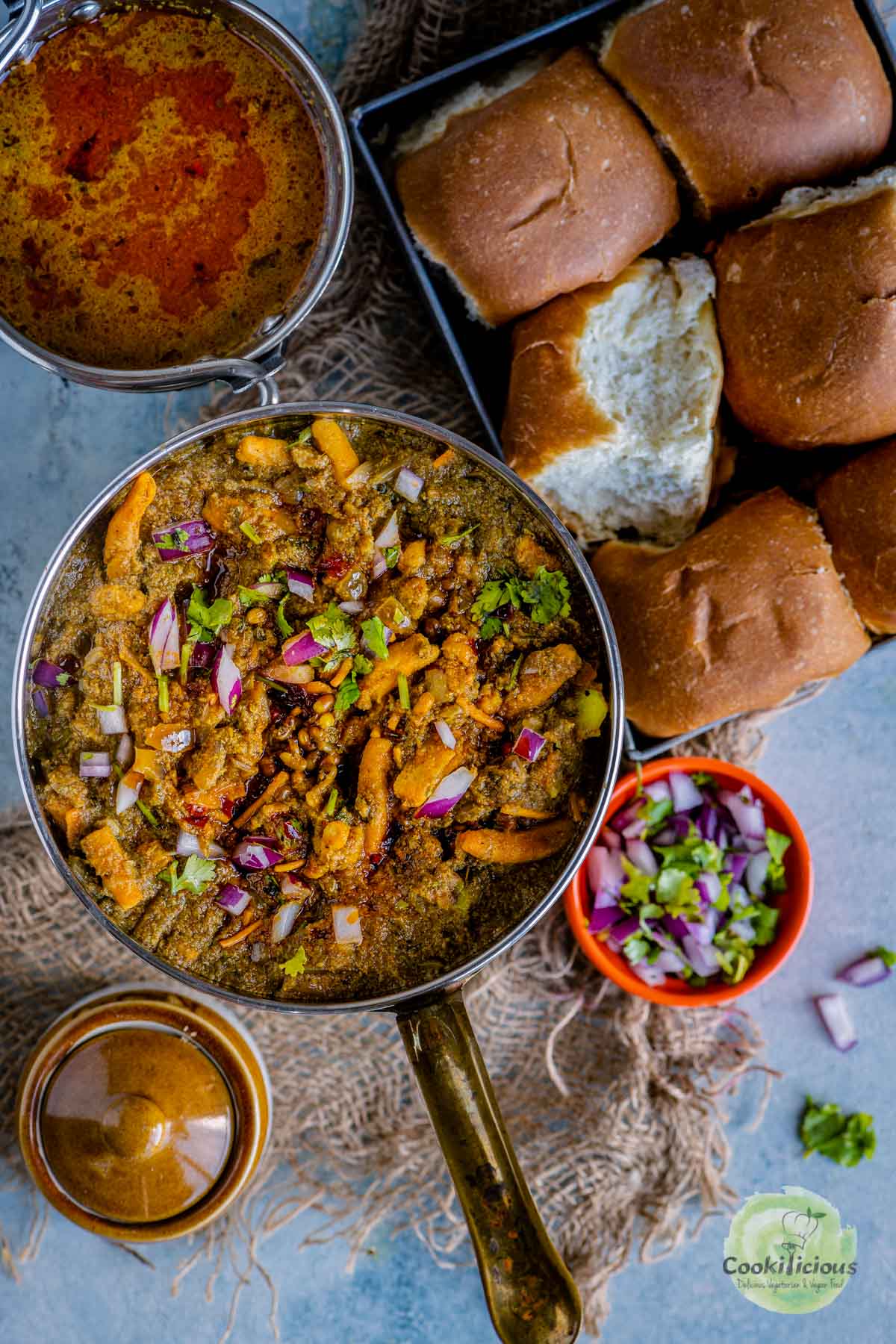
⭐️ Subscribe to the Cookilicious Newsletter and receive new recipes straight to your inbox! You'll receive my FREE Vegan Beginner's guide as a gift. Ready to elevate your cooking game? Purchase my Cookbook - The Essential Vegan Indian Cookbook today!
Recipe 📖

Misal Pav Recipe
Equipment
Ingredients
To make Misal masala
- 1 tablespoon oil
- 1 tablespoon coriander seeds
- 1 tablespoon cumin seeds
- 1 cardamom pod
- 1 inch cinnamon stick
- ½ teaspoon peppercorns
- 5 cloves
- 6 cloves garlic
- ½ inch ginger
- 1 teaspoon poppy seeds
- 1 teaspoon black or white sesame seeds
- 1 cup roughly chopped onion
- ½ cup coconut chunks
- ⅓ cup water for grinding
To cook the sprouts
- 2 cups sprouts used green and brown
- 1 teaspoon turmeric powder
- 5 cups water
To make the Tarri
- 3 tablespoon oil
- 1 cup onion finely chopped
- 1 tablespoon Kashmiri red chilly powder
- ½ teaspoon turmeric powder
- 1 tablespoon Kolhapuri Kanda Lasoon Masala
- Boiled sprouts water/stock
- ¼ cup cilantro
- salt
To make Matki chi Bhaji
- 1 tablespoon oil
- 1 teaspoon mustard seeds
- 2-3 green chillies
- cooked sprouts
- 1 teaspoon Kashmiri chilly powder
- ½ teaspoon turmeric powder
- 1 tablespoon Kolhapuri Kanda Lasoon Masala
- salt
- ¼ cup cilantro finely chopped
To make the potato bhaji
- 3 boiled potatoes
- 1 tablespoon oil
- 1 teaspoon mustard seeds
- 1 teaspoon cumin seeds
- 5-6 curry leaves
- 3 green chillies
- ½ cup onions chopped
- 1 teaspoon turmeric powder
- 2 tablespoon cilantro chopped
- salt
Other ingredients
- 12 Pav or water rolls
- 2 cups Misal farsan
- ¼ cup onions finely chopped
- 2 tablespoon cilantro finely chopped
- 1 tablespoon lemon juice
Instructions
To make Misal masala
- Roast coriander seeds, cumin seeds, peppercorns, cloves, cardamom pod, poppy seeds, sesame seeds, and cinnamon in oil for 2 minutes on low to medium flame. Chef Tip - They should just be lightly roasted and need not change color.
- Transfer to a plate.
- In the same pan, roast garlic, ginger, onion and coconut shreds. Add a teaspoon of more oil if needed. Roast for 4 minutes. Chef Tip - You can also use a grill pan here.
- Transfer to the same plate. Allow it to cool down completely.
- Then transfer all the contents to a blender jar.
- Grind it to a smooth paste by adding water gradually. Keep this misal vatan aside for now.
To cook the sprouts
- Add water, turmeric powder and sprouts to a pan. Mix, cover and cook it for 15 minutes or till the sprouts are almost done, on medium flame.
- Strain and reserve the water. That will be used to make the Tarri. Keep the cooked sprouts aside for now.
To make the Tarri
- Heat oil in the pan and fry the onions till they turn light golden brown. This could take 4-5 minutes on medium flame.
- Lower the flame and then add the Kolhapuri Kanda Lasoon masala, Kashmiri red chilly powder and turmeric powder. Mix and sauté for 2 minutes.
- Now add the ground paste along with salt. Mix and cook till the masalas are all well cooked. It could take 12-15 minutes on medium flame. Chef Tip - Add little hot water if the mixture gets too dry. Keep stirring the masala and don't forget to scrape the sides of the pan as it .
- Then add the sprouts water. I got 3.5 cups of stock. Mix and adjust the consistency as needed. I added an additional cup of water. It should be thin pouring consistency. Ensure there are no lumps.
- Cook this Tarri for 20 minutes or till the oil floats on top, on medium flame. There is no need to cover the pan. Check and add salt if needed.
- Then add chopped cilantro and give it a good mix. Tarri is now ready. You can transfer to a large bowl and keep it aside.
To make Matki chi Bhaji
- Heat oil in a pan and temper mustard seeds. Once they splutter, add the minced green chillies.
- Then add the cooked spouts.
- Followed by turmeric powder, Kashmiri red chilly powder, Kolhapuri kanda lasoon masala and salt.
- Mix and cook this for 5-6 minutes. Keep stirring at intervals. Garnish with chopped cilantro. Matki chi bhaji is ready. Transfer to a bowl and keep it aside.
To make the potato bhaji
- Boil, peel and mash or grate 3 potatoes.
- Heat oil in the same pan. Temper mustard seeds, cumin seeds, curry leaves and green chillies.
- Then add onions and saute till they turn translucent.
- Now add the mashed potatoes along with salt and turmeric powder.
- Mix and cook for 4-5 minutes. Keep mashing some potatoes while cooking.
- Garnish with chopped cilantro. Mix and take it off the flame. Transfer to another bowl.
To assemble the misal pav
- In a small plate, add a portion of potato bhaji.
- Then add the matki chi bhaji on top.
- Top with a generous helping of farsan.
- Pour the tarri on top.
- Garnish with chopped onions and cilantro.
- Add some lemon juice on top and serve with pav.

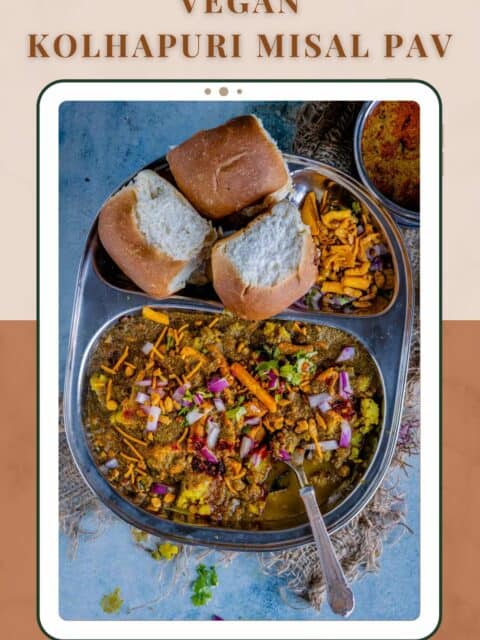
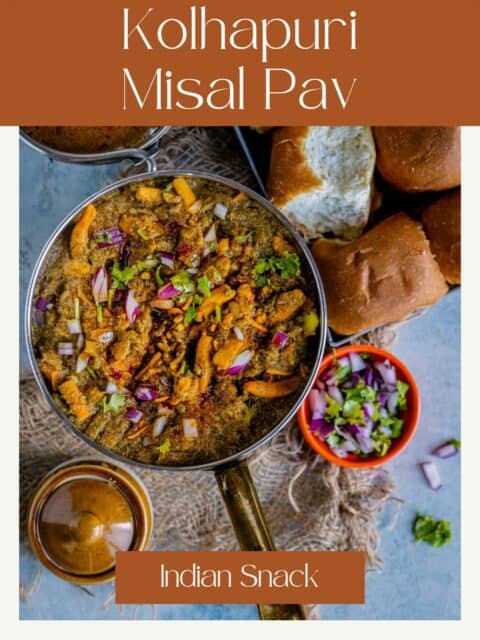

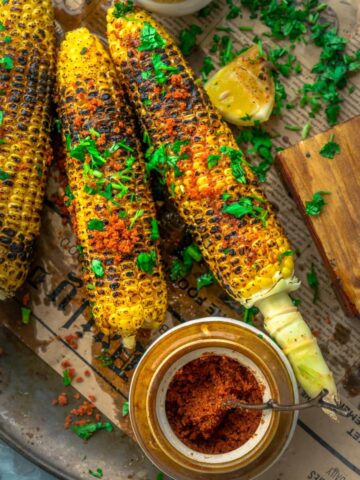
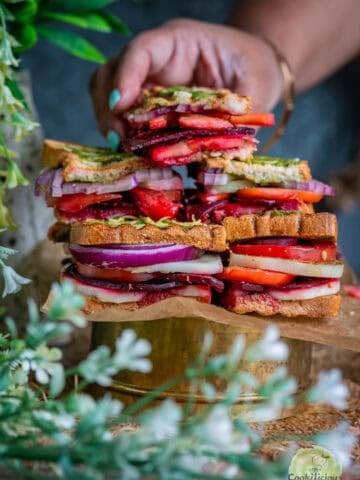
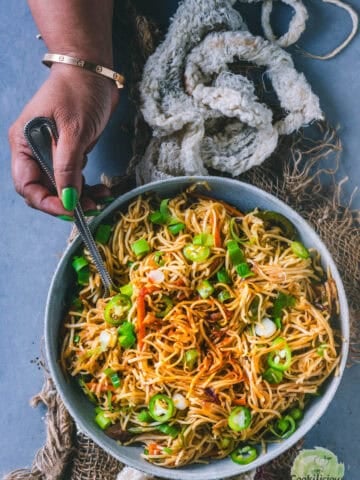
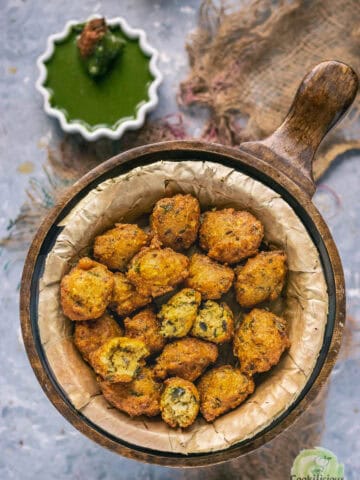

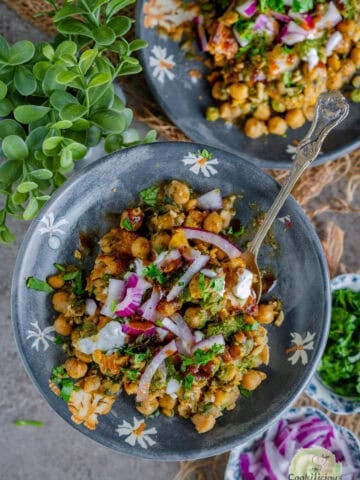

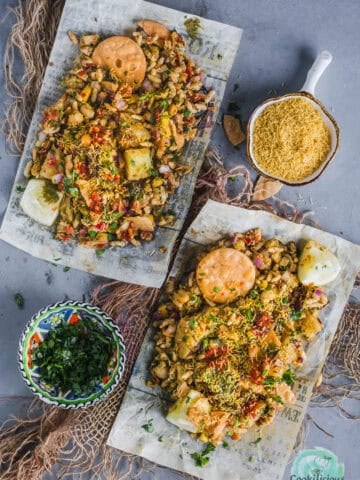
Leave a Reply